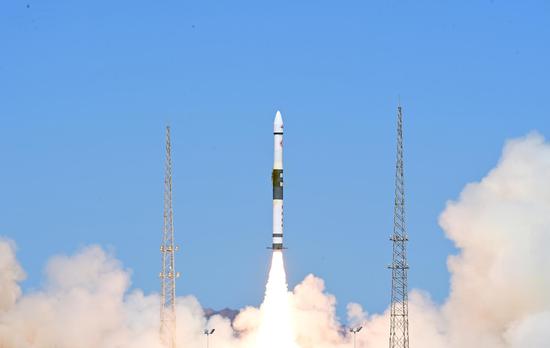
A scene inside the International Monetary Fund headquarters in Washington on April 13, 2023. The IMF released the July update to its World Economic Outlook on Tuesday, predicting global growth to fall from an estimated 3.5 percent in 2022 to 3 percent both this year and next. (Photo by Zhao Huanxin/China Daily)
IMF: Forecast closely mirrors situation on ground
The global economic landscape has been changing continuously since the start of the year, with ups and downs predicted for various countries, but the forecast for China has remained constant since January: growing at 5.2 percent in 2023, and 4.5 percent next year.
The figures are according to the quarterly update of the World Economic Outlook, released on Tuesday by the International Monetary Fund, which predicted that global growth would fall from an estimated 3.5 percent in 2022 to 3 percent this year and next.
Compared with projections that IMF made in April, global growth has been upgraded by 0.2 percentage point for 2023, with no change for 2024. Still, it remains well below the historical annual average of 3.8 percent seen between 2000 and 2019.
For China, the IMF projected in January that the country's economy would expand by 5.2 percent this year from 3 percent last year, as mobility and activity picked up after the lifting of pandemic restrictions, though it still faced significant economic challenges, including the contraction in the real estate sector.
The global lender has reiterated its growth rate prediction for the world's second-largest economy in its July forecast, as it did in April, though Wall Street has changed GDP forecasts for China nearly every month so far this year.
In comparison, the US growth rate is projected to slow down from 2.1 percent in 2022 to 1.8 percent in 2023, and then slow further to 1 percent in 2024. For 2023, the forecast has been revised upward by 0.2 percentage point from the July projection, while for 2024, the forecast is down by 0.1 percentage point, according to the IMF.

The financial district of Pudong New Area. (Photo by Gao Erqiang/China Daily)
The forecast for China closely mirrors the situation on the ground, as the National Bureau of Statistics last week said that China's GDP grew 5.5 percent year-on-year in the first half of 2023, driven by stronger consumption and steadily improving services.
The IMF noted that manufacturing activity and consumption of services in China rebounded at the beginning of the year following the easing of strict lockdown policies.
It said the country's net exports contributed strongly to sequential growth in February and March as supply chains normalized and companies swiftly cleared backlog of orders.
However, the IMF document noted that continued weakness in the real estate sector is weighing on investment, foreign demand remains weak as the global economy slows, and rising youth unemployment indicates labor market weakness, meaning that following a reopening boost, China's recovery is losing steam.
But the IMF also said that stronger policy support in China than currently envisioned — particularly through means-tested transfers to households — could further sustain recovery and generate positive global spillovers.
Such support seems to be in the pipeline, as China will "carry out macroeconomic regulation with precision and force" in the second half of this year to further drive recovery, with efforts including expanding domestic demand, which is now insufficient, according to a key Party leadership meeting on Monday.
Private investment will be also given more policy support, while multiple measures should be taken to keep the country's foreign trade and investment stable, said a statement from a meeting of the Political Bureau of the Communist Party of China Central Committee. The meeting was presided over by Xi Jinping, general secretary of the CPC Central Committee.
In the past few days, China's National Development and Reform Commission and several other central departments have released two documents, detailing a score of measures to ramp up auto and electronics consumption, with a view to sustaining the recovery trend.
In a podcast released on Monday, Hui Shan, chief China economist for Goldman Sachs Research, said: "On the organic recovery side, I think we're still seeing consumption recovering, especially in the services sector and contact-intensive sectors. We see that there's still room for recovery."
She said in the dialogue titled "What's next for China's economy?" that China's economy in the third quarter should do better than in the second quarter, and for the full year, the country's growth is projected to be 5.4 percent.
International investment firms have frequently revised their forecasts for China's economy, with JPMorgan making six adjustments since January, CNBC reported on Sunday.
It said that among the six investment firms that also include Nomura, UBS, Morgan Stanley and Citigroup, the highest China GDP forecast so far this year was 6.4 percent forecast by JPMorgan.
The global economy is not yet out of the woods, though the signs of progress are undeniable, said Pierre-Olivier Gourinchas, the IMF's economic counselor and its director of research.
In a blog published on Tuesday, Gourinchas wrote that the COVID-19 pandemic is officially over, and supply chain disruptions have returned to pre-pandemic levels, with economic activity in the first quarter of the year proving resilient, despite the challenging environment.
In addition, energy and food prices have come down sharply from their conflict-induced peaks, allowing global inflation pressures to ease faster than expected, while financial instability following the March banking turmoil remains contained.
"Yet many challenges still cloud the horizon, and it is too early to celebrate," he wrote.
The balance of risks to global growth remains tilted toward the downside, as inflation could remain high and even rise if further shocks occur, and financial sector turbulence could resume as markets adjust to further policy-tightening by central banks, according to the IMF.


















































 京公网安备 11010202009201号
京公网安备 11010202009201号
